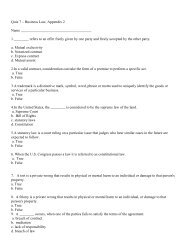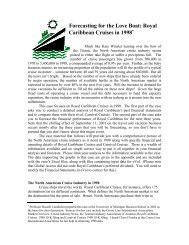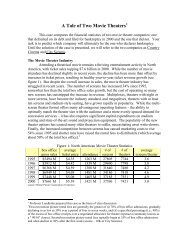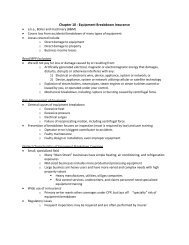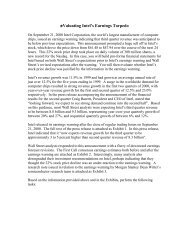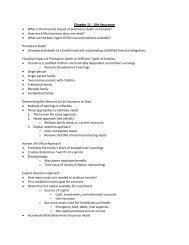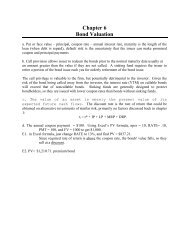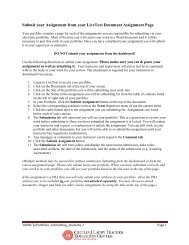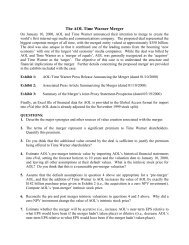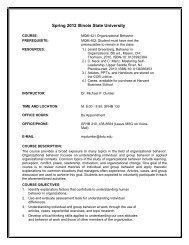Evaluating a Firm's External Environment - Illinois State University
Evaluating a Firm's External Environment - Illinois State University
Evaluating a Firm's External Environment - Illinois State University
You also want an ePaper? Increase the reach of your titles
YUMPU automatically turns print PDFs into web optimized ePapers that Google loves.
M02_BARN4586_03_SE_C02.qxd 7/1/09 7:34 AM Page 37<br />
Chapter 2: <strong>Evaluating</strong> a Firm’s <strong>External</strong> <strong>Environment</strong> 37<br />
The relationship between the five<br />
forces framework and the S-C-P<br />
model turns on the relationship<br />
between the threats identified in the<br />
framework and the nature of competition<br />
in an industry. When all five<br />
threats are very high, competition in an<br />
industry begins to approach what<br />
economists call perfect competition.<br />
When all five threats are very low,<br />
competition in an industry begins to<br />
approach what economists call a<br />
monopoly. Between perfect competition<br />
and monopoly, economists have identified<br />
two other types of competition in<br />
an industry—monopolistic competition<br />
and oligopoly—where the five threats<br />
identified in the framework are moderately<br />
high. These four types of competition,<br />
and the expected performance of<br />
firms in these different industries, are<br />
summarized in the table below.<br />
Industries are perfectly competitive<br />
when there are large numbers of<br />
competing firms, the products being<br />
sold are homogeneous with respect to<br />
cost and product attributes, and entry<br />
and exit costs are very low. An example<br />
of a perfectly competitive industry<br />
is the spot market for crude oil. Firms<br />
Strategy in Depth<br />
The Five Forces Framework and the<br />
S-C-P Model<br />
in perfectly competitive industries can<br />
expect to earn only competitive parity.<br />
In monopolistically competitive<br />
industries, there are large numbers of<br />
competing firms and low-cost entry into<br />
and exit from the industry. However,<br />
unlike the case of perfect competition,<br />
products in these industries are not<br />
homogeneous with respect to costs or<br />
product attributes. Examples of monopolistically<br />
competitive industries include<br />
toothpaste, shampoo, golf balls, and<br />
automobiles. Firms in such industries<br />
can earn competitive advantages.<br />
Oligopolies are characterized by<br />
a small number of competing firms, by<br />
homogeneous products, and by high<br />
entry and exit costs. Examples of<br />
oligopolistic industries include the<br />
U.S. automobile and steel industries in<br />
the 1950s and the U.S. breakfast cereal<br />
market today. Currently, the top four<br />
producers of breakfast cereal account<br />
for about 90 percent of the breakfast<br />
cereal sold in the United <strong>State</strong>s. Firms<br />
in such industries can earn competitive<br />
advantages.<br />
Finally, monopolistic industries<br />
consist of only a single firm. Entry into<br />
this type of industry is very costly.<br />
There are few examples of purely<br />
monopolistic industries. Historically,<br />
for example, the U.S. Post Office had a<br />
monopoly on home mail delivery.<br />
However, this monopoly has been<br />
challenged in small-package delivery<br />
by FedEx, larger-package delivery by<br />
UPS, and in mail delivery by e-mail.<br />
Monopolists can generate competitive<br />
advantages—although they are sometimes<br />
managed very inefficiently.<br />
Source: J. Barney (2007). Gaining and sustaining<br />
competitive advantage, 3rd ed. Upper Saddle River,<br />
NJ: Pearson Higher Education.<br />
Types of Competition and Expected Firm Performance<br />
Type of Competition Attributes Examples Expected Firm Performance<br />
Perfect competition Large number of firms Stock market Competitive parity<br />
Homogeneous products Crude oil<br />
Low-cost entry and exit<br />
Monopolistic<br />
Large number of firms Toothpaste<br />
Competitive advantage<br />
competition<br />
Heterogeneous products Shampoo<br />
Low-cost entry and exit Golf balls<br />
Automobiles<br />
Oligopoly<br />
Small number of firms U.S. steel and autos in the 1950s Competitive advantage<br />
Homogenous products U.S. breakfast cereal<br />
Costly entry and exit<br />
Monopoly One firm Home mail delivery Competitive advantage<br />
Costly entry



